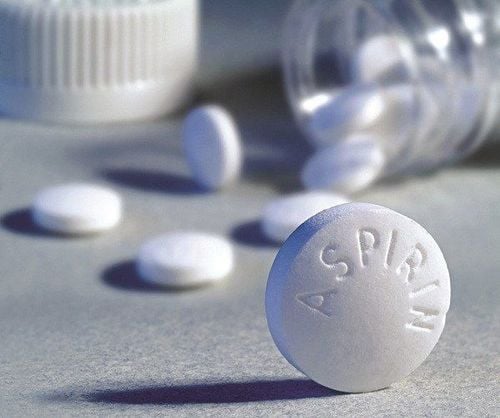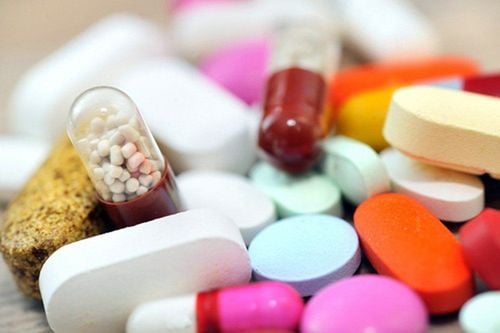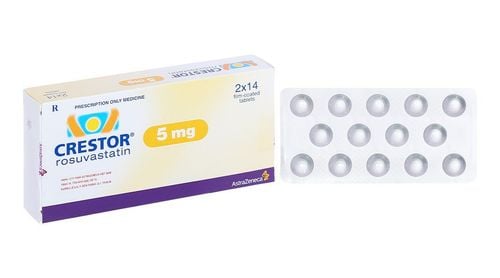This is an automatically translated article.
Vascepa works by reducing the amount of triglycerides produced by the body. The following article will help you better understand the uses, usage and notes when using Vascepa.
1. What is Vascepa?
The U.S. Food and Drug Administration (FDA) has approved the use of Vascepa (icosapent ethyl) as adjunctive therapy to reduce the risk of cardiovascular events in adults with elevated triglyceride levels (a type of blood fats) of 150 mg/dl or more, especially in patients with cardiovascular disease, diabetes, or risk factors for cardiovascular disease. The main ingredient of Vascepa is Icosapent ethyl - a polyunsaturated fatty acid found in fish oil, which acts as a precursor to thromboxane-3 and prostaglandin-3. The drug is prepared in the form of soft capsules with a content of 1 gram.Excipients: Each capsule contains 30 mg maltitol (E965 ii), 83 mg sorbitol (E420 ii) and soy lecithin. Vascepa is prescribed by doctors in cases where a patient's diet rich in eicosapentaenoic acid causes serum lipid levels to decrease, prevents platelet aggregation, reduces the rate and inhibits the conversion of arachidonic acid to arachidonic acid. prostaglandin-2 and thromboxane-2 families. Specifically in cases of reduced event risk in adults at high cardiovascular risk with triglyceride levels 150 mg/dL (equivalent to 1.7 mmol/L) on statin therapy and in patients with heart disease confirmed cardiovascular disease or disorder, the patient has diabetes, or has at least one other cardiovascular risk factor.
Vascepa is used in addition to statin therapy. Statins are medications used to treat high cholesterol levels and reduce the risk of cardiovascular events. High levels of triglycerides may play a role in the hardening or thickening of the artery walls, which can increase the risk of heart attack or stroke.
2. What is the use of Vascepa?
Mechanism of Action:
Icosapent ethyl is a stable ethyl ester of the omega-3 fatty acid, eicosapentaenoic acid (EPA). The mechanism of action of Icosapent ethyl in reducing cardiovascular events is not fully understood. Potentially multifactorial mechanisms include improved lipoprotein profile with reduced triglyceride-rich lipoproteins, anti-inflammatory and antioxidant effects, decreased macrophage accumulation, improved endothelial function, increased thickness/stabilization fibrous cap and antiplatelet effect.
Each of these mechanisms may favorably alter the growth, progression and stabilization of atherosclerotic plaque, as well as the effects of plaque rupture, and preclinical studies as well support those benefits with the EPA. The systemic and local anti-inflammatory effects of EPA may be due to the displacement of the anti-inflammatory arachidonic acid (AA), directing catabolism away from eicosanoids (2-series prostaglandins and thromboxane, and 4-series leukotrienes) to non- or anti-inflammatory mediators. However, the direct clinical significance of these individual findings is unclear.
Pharmacodynamic effects:
Absorption: Following oral administration, icosapent ethyl is de-esterified during absorption and the active metabolite EPA is absorbed in the small intestine and enters the systemic circulation mainly via the systemic circulation. thoracic duct lymphatic system. Peak plasma concentrations of EPA are reached approximately 5 hours after oral administration of icosapent ethyl. Icosapent ethyl was administered with or after meals in all clinical studies; No food effect studies have been performed. Distribution: The mean steady-state volume of distribution for EPA is approximately 88 liters. The majority of circulating EPA in plasma is conjugated in phospholipids, triglycerides and cholesterol esters, and is associated with a 50% risk of cardiovascular events. Patients with renal and hepatic impairment: The pharmacokinetics of icosapent ethyl have not been studied in patients with renal or hepatic impairment. Patients did not require routine dose adjustment due to hepatic or renal impairment in a well-controlled cardiovascular outcome study of icosapent ethyl. Contraindications of Vascepa
Patients who are allergic to any of the ingredients or excipients of Vascepa.
3. Side effects of the drug Vascepa
Common side effects:
Bleeding (11.8%); Peripheral edema (7.8%); Atrial fibrillation, atrial flutter (5.8%); Constipation (5.4%); Musculoskeletal pain (4.3%); Gout (4.3%); Rash (3.0%); Swelling of the hands, feet, or legs; chest tightness, fast heartbeat or palpitations, feeling of heaving in the chest, feeling short of breath; Dizziness, chest tightness, trouble breathing, fainting, or feeling light-headed. 4. Special warnings and precautions for use Allergy to fish and/or shellfish: Icosapent ethyl obtained from fish oil. Scientists do not currently know whether patients who are allergic to fish or shellfish are at increased risk of an allergic reaction to icosapent ethyl. Icosapent ethyl should be used with caution in patients with hypersensitivity to fish and/or shellfish. Hepatic impairment: In patients with hepatic impairment, alanine aminotransferase (ALT) and aspartate aminotransferase (AST) levels should be monitored as clinically indicated prior to initiation of therapy and at appropriate intervals during therapy. treatment. Atrial flutter or flutter: Icosapent ethyl is associated with an increased risk of atrial flutter or atrial fibrillation, requiring hospitalization for monitoring. The incidence of atrial fibrillation is higher in patients with a previous history of atrial fibrillation or flutter. In particular, patients with an associated medical history should be monitored for clinical evidence of atrial fibrillation or flutter (eg, dyspnea, palpitations, syncope/dizziness, chest discomfort, blood pressure changes or irregular pulse). Electrocardiographic evaluation should be performed when clinically indicated. Bleeding: Treatment with icosapent ethyl is associated with an increased rate of bleeding. Patients taking icosapent ethyl together with antithrombotics, i.e. antiplatelet agents, including acetylsalicylic acid, and/or anticoagulants, may have an increased risk of bleeding and should be regularly monitored regularly. often. Sorbitol (E420 ii) excipient content: This medicinal product contains 83 mg of sorbitol in each capsule. The side effects of concomitant medicinal products containing sorbitol (or fructose) and the amount of sorbitol (or fructose) in the diet should be taken into account. The content of sorbitol in oral medicinal products may affect the bioavailability of other medicinal products administered concurrently. Patients with hereditary fructose intolerance (HFI) should not take this medicinal product. Maltitol excipient content (E965 ii): This medicinal product contains 30 mg of maltitol in each capsule. Patients with rare hereditary problems of fructose intolerance should not take this medicinal product. Soy Lecithin: This medicinal product contains soy lecithin. Patients who are allergic to soy or peanuts should not use this medicinal product. Pregnancy: It is best to avoid the use of icosapent ethyl during pregnancy unless the benefit of use outweighs the possible risk to the fetus. Lactation: It is not known whether ethyl icosapent is excreted in human milk. Studies from the literature have shown that the active metabolite eicosapentaenoic acid (EPA) is excreted in human milk to a degree that correlates with the maternal diet. Toxicological data available in rats indicate excretion of ethyl icosapent in milk.
5. How to use Vascepa effectively
How to take: Vazka should be taken with or after a meal. To ensure that the full intended dose is received, patients should swallow the capsules whole and do not break, crush, dissolve or chew them.
Dosage:
The recommended daily dose is 4 tablets, each time 2 tablets x 2 times / day. If a dose is missed, the patient should take it as soon as he remembers. However, if a daily dose is missed, the next dose must not be doubled. Children: icosapent ethyl should not be used in children younger than 18 years of age to reduce the risk of cardiovascular events in statin-treated patients at high cardiovascular risk with elevated triglycerides and other risk factors. Above is information about the uses, how to use and note when using Vascepa medicine. To ensure safety for health and increase the effectiveness of treatment, patients need to use the drug according to the prescription and instructions of the doctor.
Please dial HOTLINE for more information or register for an appointment HERE. Download MyVinmec app to make appointments faster and to manage your bookings easily.













